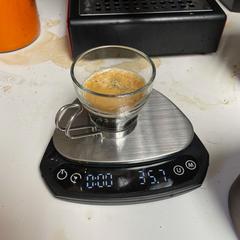Cremissimo arabica decaf
The fourth ESE pod up for review is the decaf arabica espresso by Cremissimo.
Upon opening, the pod smells like… pretty standard coffee, really. The puck is good and firm, and feels well-compacted. Pods are 7g.
For the first shot I did 24g out (3.4:1, for a longer-than-usual lungo). The resulting coffee was pretty smooth, with a slightly bitter finish and some sweet notes. There wasn’t anything about the flavor which particularly grabbed me; it tasted like a pretty ordinary espresso shot. Which, if we’re being honest, is a good thing. As usual I used the bottomless portafilter, and I didn’t see any channeling take place.
Shot 2 I only took to 14 grams, and paradoxically this was much more bitter than the first one. It tasted like the sort of espresso you’d get at a major coffee chain, or one of those mall kiosks.
And, finally, I did a 125g/4.4oz “shotover,” which took over 2 minutes to pull. It tasted like gas station coffee.
So, overall I would not recommend it. It seems to be good for lungo shots and nothing else, and even then, I’ve had better.

